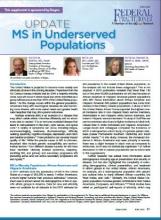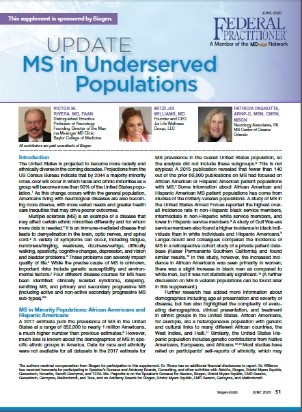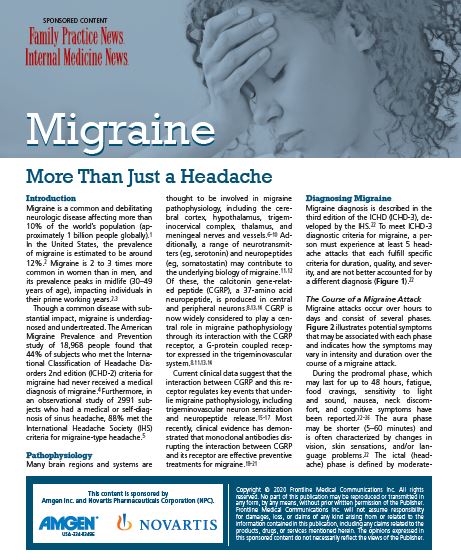User login
Assessing Spinal Muscular Atrophy Across the Patient Journey
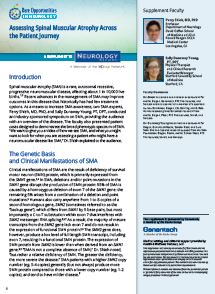
Click here to read.
Supplement Faculty
Perry Shieh, MD, PhD
Professor
Department of Neurology
David Geffen School
of Medicine at UCLA
Ronald Reagan UCLA
Medical Center
Los Angeles, CA
Sally Dunaway Young, PT, DPT
Physical Therapist
and Clinical Research
Evaluator/Manager
Stanford University School
of Medicine
Stanford, CA

Click here to read.
Supplement Faculty
Perry Shieh, MD, PhD
Professor
Department of Neurology
David Geffen School
of Medicine at UCLA
Ronald Reagan UCLA
Medical Center
Los Angeles, CA
Sally Dunaway Young, PT, DPT
Physical Therapist
and Clinical Research
Evaluator/Manager
Stanford University School
of Medicine
Stanford, CA

Click here to read.
Supplement Faculty
Perry Shieh, MD, PhD
Professor
Department of Neurology
David Geffen School
of Medicine at UCLA
Ronald Reagan UCLA
Medical Center
Los Angeles, CA
Sally Dunaway Young, PT, DPT
Physical Therapist
and Clinical Research
Evaluator/Manager
Stanford University School
of Medicine
Stanford, CA
VEGF Inhibitors and Ophthalmic Diseases
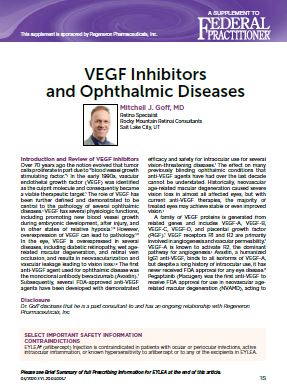
Click here to read the supplement.
Author
Retina Specialist
Rocky Mountain Retinal Consultants
Salt Lake City, UT
1. Apte RS, Chen DS, Ferrara N. VEGF in signaling and disease: beyond discovery and development. Cell. 2019;176(6):1248-1264.

Click here to read the supplement.
Author
Retina Specialist
Rocky Mountain Retinal Consultants
Salt Lake City, UT
1. Apte RS, Chen DS, Ferrara N. VEGF in signaling and disease: beyond discovery and development. Cell. 2019;176(6):1248-1264.

Click here to read the supplement.
Author
Retina Specialist
Rocky Mountain Retinal Consultants
Salt Lake City, UT
1. Apte RS, Chen DS, Ferrara N. VEGF in signaling and disease: beyond discovery and development. Cell. 2019;176(6):1248-1264.
Update: MS in Underserved Populations
As the United States population becomes increasingly diverse, the population of Americans living with neurological diseases such as multiple sclerosis (MS) will have more varied needs and greater health care inequities that may drive poorer outcomes.
In this supplement to Federal Practitioner, Victor M. Rivera, MD, FAAN, Mitzi Joi Williams, MD, and Patricia Pagnotta, ARNP-C, MSN, CNRN, MSCN discuss MS in minority populations such as African Americans, Hispanic Americans, and the military-veteran population. Topics include population-specific risk factors, disparities in clinical trial participation, and recommendations for improved MS management.
This supplement is sponsored by Biogen.
As the United States population becomes increasingly diverse, the population of Americans living with neurological diseases such as multiple sclerosis (MS) will have more varied needs and greater health care inequities that may drive poorer outcomes.
In this supplement to Federal Practitioner, Victor M. Rivera, MD, FAAN, Mitzi Joi Williams, MD, and Patricia Pagnotta, ARNP-C, MSN, CNRN, MSCN discuss MS in minority populations such as African Americans, Hispanic Americans, and the military-veteran population. Topics include population-specific risk factors, disparities in clinical trial participation, and recommendations for improved MS management.
This supplement is sponsored by Biogen.
As the United States population becomes increasingly diverse, the population of Americans living with neurological diseases such as multiple sclerosis (MS) will have more varied needs and greater health care inequities that may drive poorer outcomes.
In this supplement to Federal Practitioner, Victor M. Rivera, MD, FAAN, Mitzi Joi Williams, MD, and Patricia Pagnotta, ARNP-C, MSN, CNRN, MSCN discuss MS in minority populations such as African Americans, Hispanic Americans, and the military-veteran population. Topics include population-specific risk factors, disparities in clinical trial participation, and recommendations for improved MS management.
This supplement is sponsored by Biogen.
Migraine Management: What Primary Care Providers Need to Know
Migraine is a long-term, disabling neurologic disease that has a severe impact on the lives of patients living with it.1-3 Patients who experience frequent migraine attacks may require a multidisciplinary approach, which includes a combination of acute and preventive modalities as well as behavioral interventions as part of their treatment plan.4
This sponsored content shares ways in which patients with migraine may successfully manage their conditions and minimize impact on their lives with the support of their health care teams within primary care.4
References:
1 Lipton RB, Bigal ME, Diamond M, Freitag F, Reed ML, Stewart WF. Neurology. 2007;68(5):343-349.
2 Buse DC, Rupnow MFT, Lipton RB. Mayo Clin Proc. 2009;84(5):422-435.
3 GBD 2017 Disease and Injury Incidence and Prevalence Collaborators. Lancet. 2018;392(10159):1789-1858.
4 American Headache Society. Headache. 2019;59(1):1-18.
USA-334-83662
Migraine is a long-term, disabling neurologic disease that has a severe impact on the lives of patients living with it.1-3 Patients who experience frequent migraine attacks may require a multidisciplinary approach, which includes a combination of acute and preventive modalities as well as behavioral interventions as part of their treatment plan.4
This sponsored content shares ways in which patients with migraine may successfully manage their conditions and minimize impact on their lives with the support of their health care teams within primary care.4
References:
1 Lipton RB, Bigal ME, Diamond M, Freitag F, Reed ML, Stewart WF. Neurology. 2007;68(5):343-349.
2 Buse DC, Rupnow MFT, Lipton RB. Mayo Clin Proc. 2009;84(5):422-435.
3 GBD 2017 Disease and Injury Incidence and Prevalence Collaborators. Lancet. 2018;392(10159):1789-1858.
4 American Headache Society. Headache. 2019;59(1):1-18.
USA-334-83662
Migraine is a long-term, disabling neurologic disease that has a severe impact on the lives of patients living with it.1-3 Patients who experience frequent migraine attacks may require a multidisciplinary approach, which includes a combination of acute and preventive modalities as well as behavioral interventions as part of their treatment plan.4
This sponsored content shares ways in which patients with migraine may successfully manage their conditions and minimize impact on their lives with the support of their health care teams within primary care.4
References:
1 Lipton RB, Bigal ME, Diamond M, Freitag F, Reed ML, Stewart WF. Neurology. 2007;68(5):343-349.
2 Buse DC, Rupnow MFT, Lipton RB. Mayo Clin Proc. 2009;84(5):422-435.
3 GBD 2017 Disease and Injury Incidence and Prevalence Collaborators. Lancet. 2018;392(10159):1789-1858.
4 American Headache Society. Headache. 2019;59(1):1-18.
USA-334-83662
Migraine: More Than Just a Headache
Though a common neurologic disease with substantial impact, migraine is underdiagnosed and undertreated.1,2 The American Migraine Prevalence and Prevention study of 18,968 people found that approximately 44% of subjects who met the International Classification of Headache Disorders 2nd edition (ICHD-2) criteria for migraine had never received a medical diagnosis of
migraine.2
This sponsored content discusses the pathophysiology, characteristic symptoms, and burden of migraine, as well as how to help facilitate the diagnosis of migraine in the primary care setting.
This content is sponsored by Amgen Inc. and Novartis Pharmaceuticals Corporation.
Reference:
1 GBD 2017 Disease and Injury Incidence and Prevalence Collaborators. Lancet. 2018;392(10159): 1789-1858.
2 Diamond S, Bigal ME, Silberstein S, Loder E, Reed M, Lipton RB. Headache. 2007;47(3):355-363.
USA-334-83661
Though a common neurologic disease with substantial impact, migraine is underdiagnosed and undertreated.1,2 The American Migraine Prevalence and Prevention study of 18,968 people found that approximately 44% of subjects who met the International Classification of Headache Disorders 2nd edition (ICHD-2) criteria for migraine had never received a medical diagnosis of
migraine.2
This sponsored content discusses the pathophysiology, characteristic symptoms, and burden of migraine, as well as how to help facilitate the diagnosis of migraine in the primary care setting.
This content is sponsored by Amgen Inc. and Novartis Pharmaceuticals Corporation.
Reference:
1 GBD 2017 Disease and Injury Incidence and Prevalence Collaborators. Lancet. 2018;392(10159): 1789-1858.
2 Diamond S, Bigal ME, Silberstein S, Loder E, Reed M, Lipton RB. Headache. 2007;47(3):355-363.
USA-334-83661
Though a common neurologic disease with substantial impact, migraine is underdiagnosed and undertreated.1,2 The American Migraine Prevalence and Prevention study of 18,968 people found that approximately 44% of subjects who met the International Classification of Headache Disorders 2nd edition (ICHD-2) criteria for migraine had never received a medical diagnosis of
migraine.2
This sponsored content discusses the pathophysiology, characteristic symptoms, and burden of migraine, as well as how to help facilitate the diagnosis of migraine in the primary care setting.
This content is sponsored by Amgen Inc. and Novartis Pharmaceuticals Corporation.
Reference:
1 GBD 2017 Disease and Injury Incidence and Prevalence Collaborators. Lancet. 2018;392(10159): 1789-1858.
2 Diamond S, Bigal ME, Silberstein S, Loder E, Reed M, Lipton RB. Headache. 2007;47(3):355-363.
USA-334-83661
First-Line Treatment of IDA in NDD-CKD
In this supplement to Internal Medicine News, Kamyar Kalantar-Zadeh, MD, MPH, PhD, discusses a first-line treatment option for iron deficiency anemia (IDA) in patients with non-dialysis-dependent chronic kidney disease (NDD-CKD). Topics include:
- The interplay between IDA and CKD
- Recognizing IDA in patients with CKD
- First-line treatment efficacy and safety information
In this supplement to Internal Medicine News, Kamyar Kalantar-Zadeh, MD, MPH, PhD, discusses a first-line treatment option for iron deficiency anemia (IDA) in patients with non-dialysis-dependent chronic kidney disease (NDD-CKD). Topics include:
- The interplay between IDA and CKD
- Recognizing IDA in patients with CKD
- First-line treatment efficacy and safety information
In this supplement to Internal Medicine News, Kamyar Kalantar-Zadeh, MD, MPH, PhD, discusses a first-line treatment option for iron deficiency anemia (IDA) in patients with non-dialysis-dependent chronic kidney disease (NDD-CKD). Topics include:
- The interplay between IDA and CKD
- Recognizing IDA in patients with CKD
- First-line treatment efficacy and safety information
The Changing Landscape of Acute Migraine
Acute migraine onset results in 1.2 million emergency room visits and costs Americans $36 billion in health care expenditures annually, with the additional financial toll of 157 million lost workdays and unknown damage incurred by associated psychologic comorbidities.
In this supplement, Robert Cowan, MD discusses the latest understanding of acute migraine etiology, as well as updates in diagnostics, clinical trial design, and treatment options.
Acute migraine onset results in 1.2 million emergency room visits and costs Americans $36 billion in health care expenditures annually, with the additional financial toll of 157 million lost workdays and unknown damage incurred by associated psychologic comorbidities.
In this supplement, Robert Cowan, MD discusses the latest understanding of acute migraine etiology, as well as updates in diagnostics, clinical trial design, and treatment options.
Acute migraine onset results in 1.2 million emergency room visits and costs Americans $36 billion in health care expenditures annually, with the additional financial toll of 157 million lost workdays and unknown damage incurred by associated psychologic comorbidities.
In this supplement, Robert Cowan, MD discusses the latest understanding of acute migraine etiology, as well as updates in diagnostics, clinical trial design, and treatment options.
MS Highlights from ACTRIMS/ECTRIMS
This supplement to Neurology Reviews compiles news briefs from the 35th Congress of the European Committee for Treatment and Research in Multiple Sclerosis (ECTRIMS), held in Stockholm, Sweden, and the 5th annual Americas Committee for Treatment and Research in Multiple Sclerosis (ACTRIMS) Forum, held in West Palm Beach, Florida.
Click here to read the supplement
This supplement to Neurology Reviews compiles news briefs from the 35th Congress of the European Committee for Treatment and Research in Multiple Sclerosis (ECTRIMS), held in Stockholm, Sweden, and the 5th annual Americas Committee for Treatment and Research in Multiple Sclerosis (ACTRIMS) Forum, held in West Palm Beach, Florida.
Click here to read the supplement
This supplement to Neurology Reviews compiles news briefs from the 35th Congress of the European Committee for Treatment and Research in Multiple Sclerosis (ECTRIMS), held in Stockholm, Sweden, and the 5th annual Americas Committee for Treatment and Research in Multiple Sclerosis (ACTRIMS) Forum, held in West Palm Beach, Florida.
Click here to read the supplement
Monoclonal Antibodies and Small-Molecule Drugs: What General Neurologists Need to Know

Click here to read the content.
USA-334-83757

Click here to read the content.
USA-334-83757

Click here to read the content.
USA-334-83757
